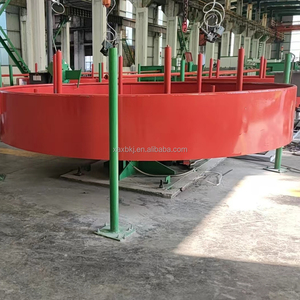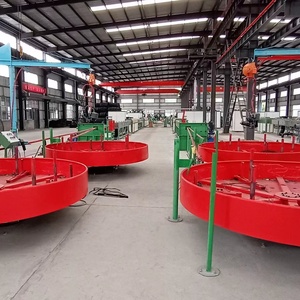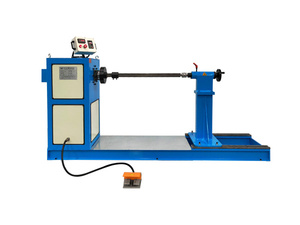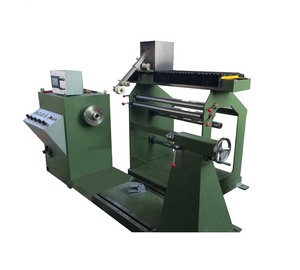
All categories
Featured selections
Trade Assurance
Buyer Central
Help Center
Get the app
Become a supplier

(2366 products available)





















Market Overview: The coil core winding machines market is experiencing robust growth, with a notable increase from USD 4.89 billion in 2023 to USD 5.23 billion in 2024. This growth trajectory is expected to continue, with a projected compound annual growth rate (CAGR) of 7.00%, reaching USD 7.86 billion by 2030, according to 360iResearch™. This expansion is fueled by rising demand across various sectors, such as automotive and electronics, where the efficiency of coil winding machines is critical for manufacturing electromagnetic components. Additionally, the global market for coil wound devices, which encompasses products utilizing these machines, was valued at USD 112.8 billion in 2023 and is anticipated to grow to USD 165.6 billion by 2030, further underscoring the importance of coil core winding machines in the broader industrial machinery landscape.
Regional Insights and Consumer Trends: The U.S. market for coil winding machines is substantial, valued at USD 29.5 billion in 2023, with China showing impressive growth prospects at a forecasted CAGR of 8.8% to reach USD 38.6 billion by 2030, as noted by Global Industry Analysts, Inc. Consumer behavior is shifting towards automation and efficiency, driving manufacturers to adopt advanced coil winding technologies. Furthermore, the market is seeing a diversification in distribution channels, with an increasing shift towards e-commerce platforms like Alibaba.com, where buyers can easily access a wide range of machinery. The ongoing digital transformation and the rising trend of smart manufacturing are also influencing the market dynamics, compelling stakeholders to innovate and meet evolving customer expectations.
The process of making a transformer involves using a specialized tool called a coil winding machine. Many vendors sell them online. The coil winding machine consists of several parts that work together to perfectly wind coils. Some parts include the spindle, clamp, and bobbin holder.
A coil winding machine can be used where precise winding is essential, such as in inductors, sensors, transformers, and motors. It is commonly employed in electronics and manufacturing industries. One perfect feature of the machine is that it can be programmed to wind coils of varying sizes and shapes.
The big advantage of a coil winding machine is that it allows for consistent and accurate coil winding. This is impossible if one were to do it by hand. This is especially important in electronic components where even the smallest error in coil winding can lead to malfunction or decreased performance.
Using a coil winding machine increases productivity. It achieves high volumes of winding within a short period. This is critical in modern manufacturing as companies are always looking for ways to streamline processes and improve efficiency. It also ensures that the products have superior quality and increased durability.
Coil winding machines are generally used inductor sensors, transformers, and motors, all of which are very important in the electronics world. There are several types of coil winding machines to suit different needs.
Machine Dimension
The core coil winding machine's dimension varies based on its type and purpose. For example, an inductance coil winder may have a compact size like 700x700x1600mm, whereas a large core coil winder may have a dimension of 2480x1780x2200mm. The machine's dimension also affects its weight. For instance, with a dimension of 700x700x1600mm, the winder weighs 160kg, while a massive one with 2480x1780x2200mm weighs 1550kg.
Worktable
Depending on the model, the worktable can size 250x250mm up to 500x500mm. A large worktable, such as 500x500mm, will allow winding of larger workpieces. The core diameter, on the other hand, ranges from a minimum of 5mm to a maximum of 140mm. It enables the user to wind a workpiece with varying shaft sizes. Additionally, the machine has a vertical and horizontal travel with a distance of up to 200mm.
Power Supply
Depending on the model, the core coil winding machine has different power and voltage. Generally, the machine's power is approximately 0.55KW, and the voltage is 220V.
Coil Winding Tension
Some core coil winding machines have adjustable tension to ensure that the coils are consistent and uniform. It also prevents the wire from getting loose or distorted while winding. The tension can range from 1N to 10N.
Control System
A core coil winding machine has various control systems, such as PLC (Programmable Logic Controller) and Digital/Analog Controllers. The Digital/Analog Coil Winder Controller allows the user to adjust parameters like speed and count digitally. On the other hand, the PLC Coil Winder has a more sophisticated control, enabling precision and automation in the winding process.
For the core coil winding machine to operate smoothly and for a long time, it is essential to maintain it appropriately. Here are some maintenance tips:
Due to their flexibility, efficiency, and precision, coil core winding machines are utilized in a variety of industrial sectors and applications.
Electronics Manufacturing:
Automatic coil winder machines are widely used in electronics manufacturing to wind coils for various electronic components. Technologies like relays, transformers, inductors, speakers, and headphones all require wire winding.
For example, in manufacturing inductive components, they wind wires around specific cores following precise patterns. Their high accuracy ensures correct inductance values, and their productivity meets the needs of mass production.
Electrical Apparatus Production:
Coil core winding machines are also used in making electrical appliances. Electrical appliances often contain inductors or transformers that require precise wire winding.
Automotive Parts Manufacturing:
In the automotive industry, coil winding machines for transformers are indispensable. They wind coils for vehicle electric parts such as motors, relays, and sensors.
Precision, consistency, and quality stability of the winding process are crucial since automotive parts must adhere to stringent quality requirements and endurance standards.
Motor Manufacturing:
CNC coil winding machines are widely used in motor manufacturing. Their winding process provides the necessary stator and rotor coils for various motors.
The machines meet the high demands of consistency and precision essential for motor products. Additionally, they enhance productivity, satisfying the requirements for large-scale motor production.
Medical Device Production:
Some medical devices also employ coil core winding machines. For instance, the inductive sensors and transformers within them are required to be precisely wound and consistent, which is crucial to ensuring the operational stability and reliability of medical equipment.
Aerospace Industry Applications:
Coil core winding machines are widely used in aerospace industries. High-precision automatic coil winders are essential to making aerospace equipment and components like satellites, spacecraft, and aircraft.
They are used explicitly for winding precise coils, such as those for sensors, telemetry systems, and more; these components play an essential role in the control, navigation, and communication of aerospace devices, demanding high accuracy and reliability from the winding machines.
Communication Equipment Production:
Coil winding machines are extensively used in manufacturing communication equipment. Such as telecommunication devices, base stations, and networking components.
There are a few things around the working principles and general features of a coil winding machine that should be considered before investment. One great aspect of these machines is that they are very easy to use and understand, but user-friendliness is still something that needs to be looked at upon buying.
Consider training requirements in this case. Will the machine need an advanced-level training requirement, or can it be used by someone with an elementary understanding of the industry? Does it require any specific knowledge or skills related to any electrical or computerized system? It would help if you also considered before purchasing that the staff could operate the machine correctly and safely. It would also help to consider what training will be needed before buying the machinery.
It would help if buyers also considered downtime in case of maintenance and repair services. If the supplier cannot offer comprehensive services and solutions in far-off regions, it would help to consider whether the staff or any local service provider can support it. It is always a good idea to research the coil winding machine supplier and check their service records and reputation so that one can be promptly supported when the need arises.
It is critical to ensure that the machine complies with set safety standards. Are there any emergency stop features or safety guards that can safely run the coil-winding process? The safety features become paramount in large-scale industry roles where multiple professionals are working with different types of machinery across the manufacturing facility.
The payment method will also play a role in deciding which type of machine one will eventually buy. Is it a one-time purchase, or will it come together with a service and maintenance contract in which regular payments will be made? This will help in deciding what type of machine is economically more reasonable in terms of capital expenditure, operational expenditure, and overall coil production line. In production lines with a high-turn-around-time and more significant output requirement, it is essential to consider what type of machinery can produce more coils to meet current demands.
Q1: What is the difference between automatic and semi-automatic coil winding machines?
A1: In an automatic coil winding machine, the operator doesn't have to control the winding process. The machine does the winding by itself. The operator only has to load the workpiece and do some minor tasks. In a semi-automatic coil winding machine, the operator has to control the winding speed and direction while winding. So, semi-automatic machines require more operator involvement.
Q2: Can a coil winding machine be used to wind multiple layers of coils?
A2: Some coil winding machines can be used to wind multiple layers of coils. These machines have adjustable winding heads and تختلف التحكم في السرعة والاتجاهات للسماح بالتحكم الدقيق في عملية اللف. من المستحسن التشاور مع الشركة المصنعة أو المورد لتحديد ما إذا كانت الآلة المحددة يمكن أن تستخدم لعمل طبقات متعددة من الملفات.
Q3: What are the benefits of using a coil winding machine in an operation?
A3: Using a coil winding machine in an operation has many benefits, such as improved accuracy, Increased efficiency, enhanced safety, flexibility, quality control, and cost-effectiveness.
Q4: Can a coil winding machine create custom coil dimensions?
A4: Yes, a coil winding machine can create custom coil dimensions. The operator only has to input the desired coil dimension in the machine's control panel. The machine will then wind the coil to the specified dimensions.